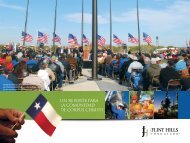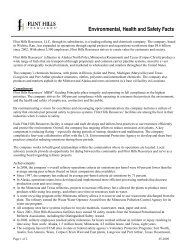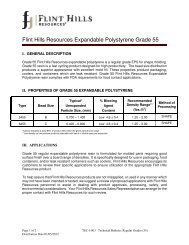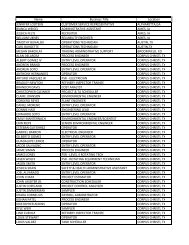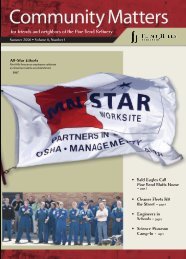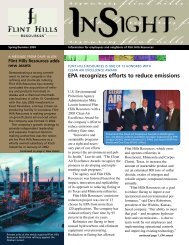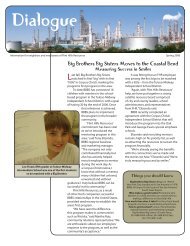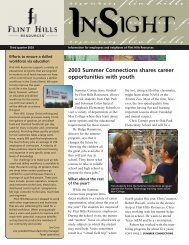for friends and neighbors of the Pine Bend Refinery - Flint Hills ...
for friends and neighbors of the Pine Bend Refinery - Flint Hills ...
for friends and neighbors of the Pine Bend Refinery - Flint Hills ...
You also want an ePaper? Increase the reach of your titles
YUMPU automatically turns print PDFs into web optimized ePapers that Google loves.
S T R A I G H T T A L K<br />
Building On Our Success<br />
Several years ago, we set out a vision to<br />
reduce flaring at <strong>Pine</strong> <strong>Bend</strong>, using it only<br />
<strong>for</strong> emergencies like a power outage or<br />
mechanical failure in one <strong>of</strong> <strong>the</strong> refinery process<br />
units (<strong>the</strong> flare is <strong>the</strong> orange or yellow flame sometimes<br />
seen at <strong>the</strong> top <strong>of</strong> <strong>the</strong> highest stacks).This was<br />
a challenging goal. The refinery averaged 75 hours<br />
<strong>of</strong> flaring per month <strong>the</strong>n. Some people probably<br />
thought it was an unrealistic goal to achieve.<br />
However, in 2002, <strong>Pine</strong> <strong>Bend</strong> employees helped<br />
make that vision a reality when <strong>the</strong> refinery<br />
Jeff Wilkes<br />
averaged just over 4 hours <strong>of</strong> flaring per month.<br />
Employees also achieved a refinery record — 62<br />
consecutive days without flaring.<br />
I congratulate everyone at <strong>Pine</strong> <strong>Bend</strong>. These are impressive<br />
milestones. <strong>Pine</strong> <strong>Bend</strong>’s flaring per<strong>for</strong>mance in 2002 is a 93 percent<br />
reduction from 1998’s 75 hours per month average. And 62 consecutive<br />
days without flaring nearly doubled <strong>the</strong> previous refinery<br />
record <strong>of</strong> 34 days set in 2001. This level <strong>of</strong> per<strong>for</strong>mance puts <strong>Pine</strong><br />
<strong>Bend</strong> among <strong>the</strong> top refiners in <strong>the</strong> nation <strong>for</strong> flare management.<br />
How did <strong>Pine</strong> <strong>Bend</strong> employees achieve this vision? By using <strong>the</strong><br />
right equipment, knowledge, <strong>and</strong> behavior to eliminate unnecessary<br />
flaring.Improvements were made to equipment, a clear goal<br />
was set <strong>and</strong> employees took ownership to achieve <strong>the</strong> vision.<br />
The model used to reduce flaring can help us achieve our<br />
vision <strong>of</strong> an injury free workplace. Having zero injuries may seem<br />
impossible, but it is not. The same tools – equipment, knowledge,<br />
<strong>and</strong> behavior – will enable us make this vision a reality.<br />
In 2002, we made progress toward our goal <strong>of</strong><br />
zero injuries, but we still have a way to go. Our<br />
safety goal last year was to have less than nine<br />
injuries.We did achieve our goal by ending <strong>the</strong><br />
year with eight. This represents significant<br />
improvement from previous years. For example,<br />
in 1998, <strong>the</strong> refinery had 34 injuries. Our 2002 per<strong>for</strong>mance<br />
is also better than <strong>the</strong> petroleum refining<br />
industry average.<br />
However, we are not content being just better<br />
than average. Our zero-injury vision is meant to<br />
protect employees, contractors <strong>and</strong> <strong>the</strong> community.<br />
It also demonstrates that we want to be among<br />
<strong>the</strong> best safety per<strong>for</strong>mers in <strong>the</strong> industry. It will take a focused<br />
ef<strong>for</strong>t by <strong>the</strong> entire team. Employees need to have knowledge<br />
around <strong>the</strong> hazards <strong>of</strong> each task, <strong>the</strong> proper equipment to complete<br />
a task safely, <strong>and</strong> safe work behaviors.<br />
I am proud <strong>of</strong> <strong>the</strong> work everyone at <strong>Pine</strong> <strong>Bend</strong> did to achieve<br />
our vision to reduce flaring at <strong>the</strong> refinery. It shows we can<br />
achieve <strong>the</strong> high goals we set. I am confident we will achieve our<br />
goal <strong>of</strong> creating an injury-free workplace <strong>and</strong> look <strong>for</strong>ward to sharing<br />
that accomplishment with you on <strong>the</strong>se pages in <strong>the</strong> future.<br />
Jeff Wilkes,<br />
<strong>Refinery</strong> Manager <strong>and</strong><br />
Vice President <strong>of</strong> Minnesota Operations<br />
I N S I D E T H E R E F I N E R Y<br />
Full-time Fire Fighters Focus On Prevention<br />
<strong>Flint</strong> <strong>Hills</strong> Resources welcomed a talented fire fighting<br />
crew to <strong>Pine</strong> <strong>Bend</strong> last May, when <strong>the</strong> refinery <strong>for</strong>med<br />
a full-time, on-site fire department. The team focuses<br />
on preventing emergency situations.<br />
“In <strong>the</strong> past, we have relied on refinery employees serving as<br />
volunteer fire fighters <strong>and</strong> our full-time safety department to<br />
h<strong>and</strong>le emergency response. Volunteers will still be a big part<br />
<strong>of</strong> emergency response, but now <strong>the</strong>ir primary focus will be on<br />
proactive measures to prevent incidents <strong>and</strong> <strong>the</strong> full-time fire<br />
fighters will focus on initial emergency response,” said Kevin<br />
Radke, Safety Manager.<br />
This view <strong>of</strong> <strong>the</strong> Mississippi River was taken during a mock spill response drill managed<br />
by a team <strong>of</strong> local emergency response pr<strong>of</strong>essionals.Working with Wakota CAER, <strong>Pine</strong><br />
<strong>Bend</strong> refinery fire fighters were part <strong>of</strong> <strong>the</strong> emergency response team who ga<strong>the</strong>red <strong>for</strong><br />
<strong>the</strong> simulated exercise.Wakota CAER (Community Awareness <strong>and</strong> Emergency Response)<br />
is a non-pr<strong>of</strong>it organization comprised <strong>of</strong> government, industry, emergency response <strong>and</strong><br />
private sector partners in Washington <strong>and</strong> Dakota counties.<br />
For <strong>the</strong> first time ever, new Minneapolis <strong>and</strong> St. Paul<br />
fire fighters trained toge<strong>the</strong>r at a rookie training<br />
camp hosted at <strong>the</strong> <strong>Pine</strong> <strong>Bend</strong> refinery.<br />
In early May, <strong>the</strong> fire<br />
fighting team enrolled<br />
in an intensive eightweek<br />
course where<br />
<strong>the</strong>y received training<br />
in fighting petroleum<br />
fires, emergency<br />
response <strong>and</strong> spill<br />
response. They began<br />
work in July with a<br />
focus on maintaining<br />
emergency response<br />
equipment <strong>and</strong> o<strong>the</strong>r activities geared toward preventing<br />
emergencies. They also have participated in fire training <strong>for</strong><br />
local fire departments at <strong>the</strong> <strong>Flint</strong> <strong>Hills</strong> fire training grounds<br />
<strong>and</strong> participated in a spill response drill on <strong>the</strong> Mississippi River<br />
with o<strong>the</strong>r local companies <strong>and</strong> emergency responders.<br />
Many <strong>of</strong> <strong>the</strong> fire fighters reside in neighboring <strong>Pine</strong> <strong>Bend</strong><br />
communities <strong>and</strong> most continue to serve <strong>the</strong>ir communities as<br />
volunteer fire fighters. The training <strong>the</strong>y receive through <strong>the</strong>ir<br />
full-time work at <strong>Flint</strong> <strong>Hills</strong> Resources, especially in advanced<br />
industrial fire fighting, will help <strong>the</strong>m in <strong>the</strong>ir service to <strong>the</strong>ir<br />
local community.<br />
“The members <strong>of</strong> this new, full-time fire department are an<br />
important addition to our emergency response team,” said<br />
Jeff Wilkes, refinery manager <strong>and</strong> vice president <strong>of</strong> Minnesota<br />
operations.“They help enhance our emergency response<br />
plans <strong>and</strong> capabilities.”<br />
The fire fighters are employed by Kurtz Paramedic Services<br />
which specializes in recruiting emergency response personnel.<br />
2



